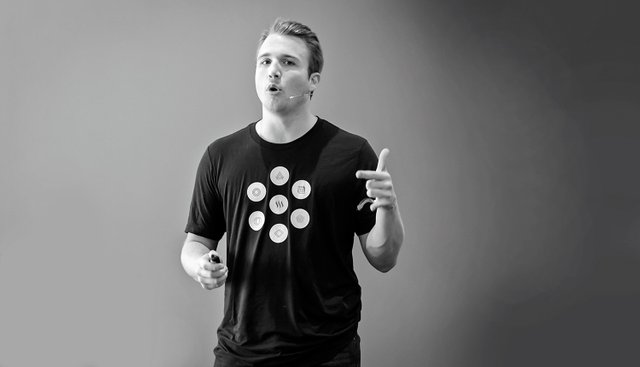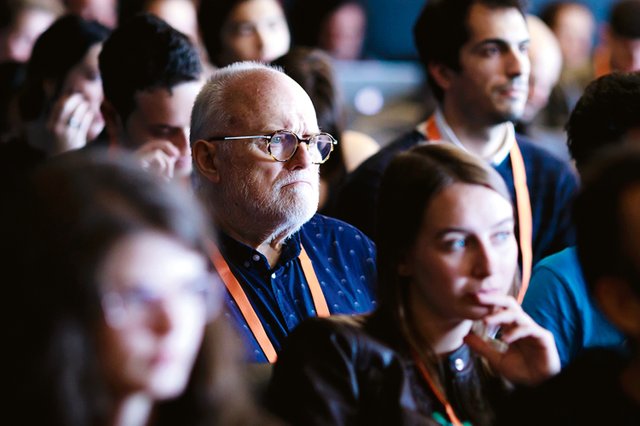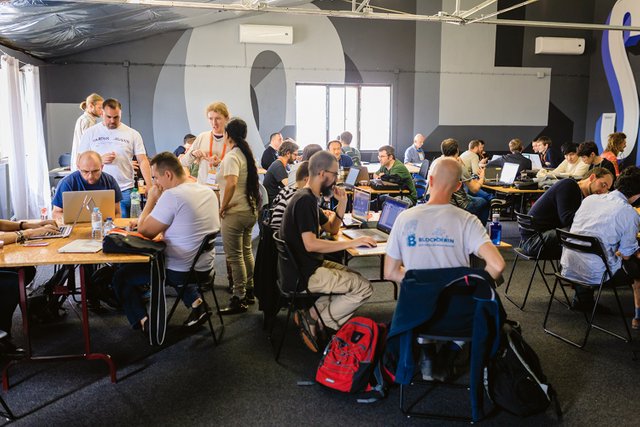Cryptocurrency Conference Steemfest Proves Bitcoin Isn't Dead Yet

As the Bitcoin rollercoaster ride continues, we go inside a conference for another cryptocurrency called Steem. There, we meet the devotees who see this new financial system as the way of the future – and the man who will lead them there.
On the stage in front of us stands a clean-shaven young man, his short brown hair slicked back at the fringe. Dressed in a plain black T-shirt and dark jeans rolled up to reveal heavy brown boots, his name is Ned Scott, a 27-year-old former-financial-analyst-turned-tech-entrepreneur who looks remarkably, well, normal.
The kind of guy who could easily slot into your social sport team, then buy you a beer after the game. But he also happens to be a millionaire many times over.
Before him sits an audience of 300 men and women who are each hoping to become as rich as Scott, simply by posting on a website named Steemit.
Co-founded by Scott, the site officially went live in July 2016 and has since paid out more than $25m in digital currency to its users. These devotees have travelled from more than 35 countries around the world – each paying as much as $1500 – for the privilege of attending this, the second annual Steemfest conference in Lisbon, Portugal.
Sporting the kind of wireless headset you might catch Madonna wearing on stage, Scott projects easy confidence as he gives a presentation to open the first day of Steemfest. Hundreds of people have gathered to pray at the altar of this new technology, which might change the shape of the world’s entrenched financial systems.
For about 15 minutes, Scott addresses the crowd, who are mostly listening in respectful silence but occasionally erupt into cheers and applause.

“The thing that’s probably more important than anything else,” Scott tells the crowd, as his talk draws to a close, “is actually something I can describe in one word.” He clicks the device in his hand to reveal the final slide of his presentation, which features just three large letters.
“You,” he announces, gazing at the neat rows of occupied seats. “You go out there, and you’re bringing the passion, interest and value to the project. Everything that you guys do is what matters. The technology is just a vehicle for you; for us. And I’m looking forward so much to what you’re going to do over the next several years, as we grow, and go to the moon.”
The crowd erupts in whoops and cheers, raising their phones to snap photos of Steemit’s leader, who looks down fondly on his flock.
It’s all very energetic. And it’s hard to avoid the feeling there is something of an air of cult-like fervour in the room. In fact, it’s a sensation that permeates the entire conference. From the jubilant reception for Scott’s keynote speech, to the closing dinner a few nights later, when the charming Dutch MC leads the crowd in a chant of “Steem! Steem! Steem!”
These people are the true believers; invested, in every sense, in a digital currency that they cannot see or touch. Which brings us to an obvious question: what exactly is Steemit?
While you’re sharing memes and holiday snaps on Facebook, these 300 devotees – and their global community of more than 400,000 Steemit users – are earning digital dollars for posting on the site.
Its point of difference from other social networks is that the entire website is powered by a cryptocurrency called Steem and each post, comment and like earns its users tiny fractions of the currency. Over time, at least in theory, it is possible to accumulate a substantial amount of @Steems that users could eventually cash in for cold, hard Aussie dollars.

Or maybe not. The site’s layout feels pretty clunky, especially for those accustomed to the smooth, easy-to-use platforms seen elsewhere on the web. Plus, we’ve been posting on Steemit for little more than a year and our estimated account value sits at around $1900.
Better than nothing, but it’s probably a little early to start picking out waterfront properties. Still, even if our contributions to Steemit eventually earn us just a single, shiny dollar, that’s a gold coin more than we ever earned posting memes on Facebook.
As anyone who’s been stuck next to a Bitcoin enthusiast at a dinner party can attest, the problem with the world of digital currencies is that it often feels like it was dreamed up by people who spend too much time in front of computers. Even the way words have been carelessly mashed together – ‘Bitcoin’, ‘blockchain’, ‘cryptocurrency’ – makes the whole ecosystem seem so inaccessible to the average man or woman on the street.
We’ve all heard stories of Bitcoin reaching historic highs – around 1000 per cent increase throughout 2017 alone – but how many could actually explain what it is? Or even how to get hold of it?
Then again, gaps in understanding are not necessarily deal-breakers when it comes to mass adoption of technology: how much do you really know about the way your smartphone works, or your microwave or even the hard-currency banking system?
In our increasingly cashless society, where tap-and-go card payments are the norm, the concept of using new technologies for daily purchases isn’t necessarily a great leap into the unknown. Credit to Steemit, then, that it demands approximately zero knowledge of the inner workings of cryptocurrency from its newest users. Pretty much anyone can sign up and start posting easily enough, just as you do on Facebook, Twitter or Instagram. Only instead of ‘likes’, you stand to earn digital money.
“Steemit is meant to be a bridge for the regular person, who probably isn’t in a position in their lives to spend 16 hours a day thinking about these technologies,” says Scott. “I do think that’s very important for the future of cryptocurrency. The Bitcoin model of telling people, ‘This a great currency system! There’s 21 million coins, it’s deflationary…’ It’s very hard to grasp for a lot of people. Steemit is a much softer on-boarding experience.”

If social media tends to induce status anxiety in its participants, who are conditioned to feel as though they’re missing out on something, then Steemit complicates matters further by appealing to the base capitalist instincts in each of us.
Here, virtual greed is good, and if you can convince yourself that a website built on a cryptocurrency is going to change the world, then you’ll fit right in. Self-interest tends to work as a motivator and the real genius of Steemit is to attract existing audiences from competing networks with the new incentive of digital dollars.
Ned Scott knows this better than anyone else here in Lisbon, even though the technology that powers the user interface on Steemit has been somewhat unwieldy to date, and requires a level of patience that may elude the average person.
On the second day of @Steemfest an audience member asks Scott how his network can compete with entrenched players such as Facebook, which is not only easy to use, but soaked into the fabric of modern life.
“Once we get there, we, as a platform, offer things that nobody else is offering,” says Scott, in response. “Would all these people be here at Steemfest, or would we have 400,000 accounts signed up on Steemit, if there was no cryptocurrency involved?”
He pauses for a moment before answering his own question – “I don’t know. I think cryptocurrency has had a lot to do with it, and nobody else has that yet…” – but the full room seems to have missed his point: the only reason any of us are here is because of the potential incentive of personal wealth.
Scott’s own Steemit wallet has an estimated value of nearly $4.5m, making it the ninth most valuable account on the site – since the time of writing, Scott’s wallet has ballooned to nearly $20m.
“It means opportunity; it means that there’s been growth,” he explains, when asked about the significance, before his typically stoic expression breaks into a grin. “And I’m excited to see it be worth a lot more!”
It was Scott who reached out to invite GQ to Lisbon, where we’re due to host a Q&A session with him. He kindly offered to cover our airfares – in Bitcoin – but in the end we opted to take the money in US dollars. It tends to be a bit more stable day-to-day and also happens to be accepted by Qantas.

Anyone who claims to know what lies ahead for Bitcoin, Steem, or any other cryptocurrency probably shouldn’t be trusted. It’s pure speculation.
Uncertainty and risk attracts gamblers, and investing in this space seems to require a particular tolerance to both factors. You want certainty? Invest in government bonds. You want excitement, a chance of riches or of losing it all? Hit the casino, bet on live sporting events, or invest in cryptocurrencies. Your fortune can change by the hour.
Before the Q&A session on day two of @Steemfest, GQ meets Scott near the bar. From time to time, people wearing Steemit shirts come up to introduce themselves to him and it’s easy to find yourself second-guessing their motives. If you happened to run into Mark Zuckerberg, you aren’t likely to leave any richer than you arrived. But if you meet Ned Scott, that selfie you took with him might just attract enough votes to boost your @Steem wallet.
When we ask Scott whether he finds this behaviour to be superficial, he responds cautiously. “Having the cryptocurrency involved, you can say it brings out the best in people,” he says. “It makes them more collaborative.”
Sure, cash is among the best incentives known to man. “You could look at it with more negative viewpoints,” he continues. “But those viewpoints are limited. I don’t think they’re seeing the full potential.”
Potential. It’s a word that floats through the air like so many utopian dreams of a cryptocurrency changing the world. We note that for more than a decade, MySpace and subsequent websites have conditioned us to endlessly talk about ourselves and our lives on the nearest available device, in an endless search for validation. Scott nods, then says, “You can describe the narcissism using the cryptocurrency aspect a little bit – whereas in Instagram and things like that, people go through a lot of effort to make it look like they’re taking candid photographs.”
Moments after we finish talking about narcissism, the attendees are hustled outside for a series of group photos taken by a swooping drone. Some hold banners bearing their Steemit usernames and before long, a handful of people begin climbing onto shoulders so that they are visible above the crowd. A dreadlocked attention-seeker in a matching white trenchcoat and top hat scales a post at the front of the group. He faces the drone with arms wide open, Messiah-like, while also blocking from view the people who stand behind him.
We can almost feel the group’s anxiety to reach for their phones, to be the first to post a comment on Steemit and make a few digital dollars before the person standing beside them has a chance. Despite Scott’s cautious words earlier, the photo opportunity plainly brings out the worst sort of behaviour in some people: unabashed, shameless self-interest.
On our final day in Lisbon, we meet an American guy from North Idaho who we’ll call Rupert, because he asked not to have his real name used. At first, he seems like he might just be the most normal person we’ve met at the conference, but his personal financial situation is about as far from typical as possible.
Rupert has recently decided to convert his entire wealth from American dollars to cryptocurrency. Here is a man who wasn’t using this technology as a speculative device that might supplement his ordinary income and investments. This guy has held nothing back.

Rupert is a 47-year-old father to seven children, one of whom – his 21-year-old food-blogging daughter – he accompanied here to Steemfest just for the hell of it.
He dresses as you’d expect a middle-aged man to dress, seeking comfort over fashion. He previously worked in network engineering, then real estate, before taking a beating when the US housing market crashed. This is a man with everything to protect, and from whom you would expect only the most fiscally conservative decisions to be made. Yet he’s recently gone all-in on Bitcoin.
What does all-in mean, in real terms? When we ask him to give some kind of estimate as to his personal wealth, he thinks for a while. “If the price stayed as it were today, none of my children will have the need to work if they choose not to,” he says. He pauses again, then adds, “My kids don’t know that, though.”
After several days of talking about cryptocurrency and its alleged world-changing potential, here’s a humble, quiet guy who just so happens to have invested his family’s entire cash savings into cryptocurrencies.
Is he a genius for being well ahead of the curve today, or will Rupert be crying into his beer tomorrow if his house of Bitcoin comes crashing down? Who knows? He certainly doesn’t. In Lisbon, we’re not sure if it was a glimpse of the future, or a pipe dream that will only ever run parallel to reality.
All currencies – digital or otherwise – are only as valuable as other people think they are. When it comes to Bitcoin, Steem and any other digital currencies you could invest in, let caution be your guide.
This is copy/pasted:
https://steemit.com/steemit/@andrewmcmillen/my-story-about-steemit-for-gq-australia-cryptocurrency-conference-steemfest-proves-bitcoin-isn-t-dead-yet-march-2018
@gabrielx2000, you need to stop.
@steemcleaners
Flagged this post for plagiarising the article I wrote for GQ Australia magazine in its entirey. Please delete this post immediately.